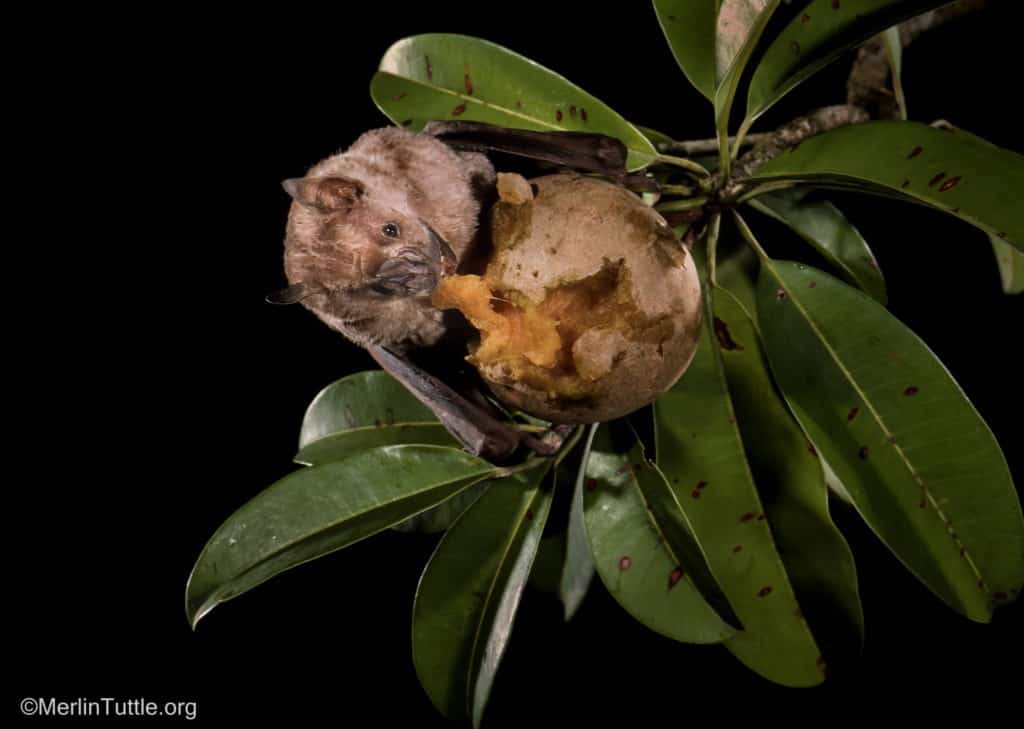Batty about Summer
It’s summertime (in the Northern Hemisphere) and the evening skies are alive with activity. As the sun sets, bugs are flying around and bats are
Halloween candy aside, it would be a stretch for most people to think of bats when they reach for a packet of chewing gum at the grocery store. But bats actually play a vital role in the ecology of the tree that helped give birth to the entire chewing gum industry.
The sapodilla (Manilkara zapota) is a tree that is native to the Yucatan and several other neighboring states in southern Mexico, as well as northern Belize and Guatemala, and became highly sought after in the 1800s for its white sap known as chicle that was used as a chewing gum. Sapodillas were brought into the U.S. sometime in the 1860s and several companies such as The Wrigley Company and Fleer began harvesting chicle from the trees – a series of diagonal cuts along the tree’s bark being the preferred method – to mass produce chewing gum. Now you know where the classic chewing gum Chiclets got its name from.
So where do the bats fit in? Bats like the yellow epauletted bat and the Seba’s short-tailed bat were key in helping sapodilla trees flourish naturally in the first place because of their role as pollinators of the sapodilla flower.
Other animals and insects have a small place in the matrix of pollinating the sapodilla flower but bats are critical because the fur on their heads and necks becomes dusted with pollen, which they transfer to the stigma of the next flower they visit. They also carry off the trees’ sweet, pear-flavored fruit, eventually dropping seeds that may grow into new trees.

Worth noting is that both the sapodilla trees and their bat pollinators are mutually dependent. Because bats expend a tremendous amount of energy while foraging each night they need to feed on sources that are either abundant or very dense in caloric energy.
Sapodilla flowers produce a quantity and variety of nectar that meets the nutritional needs of the bat species that feed from them, and the flowers – white or cream colored with a rich, musky scent – are arranged in clumps below the foliage that allow bats to navigate between them in the dark.
Another plus: since bats can cover up to 38 kilometers a day they have the ability to carry pollen over a far larger area than insect pollinators, which helps to increase the genetic diversity among the sapodilla species.
So even though chewing gum production has long since moved away from relying on the sap of the sapodilla tree, know that hungry bats helped give birth to the industry in the first place.
Love our content? Support us by sharing it!
It’s summertime (in the Northern Hemisphere) and the evening skies are alive with activity. As the sun sets, bugs are flying around and bats are
How hot is too hot? When it comes to bats and their ideal roosting temperatures, striking the right balance is crucial. We know that bats
As I rappelled down a sheer rock wall to reach the entrance to America’s most important remaining bat hibernation cave, I couldn’t believe my good
How does a community scientist from Toronto, Canada suddenly end up relocating to Austin, Texas, to work as a full-time bat biologist for Merlin Tuttle’s
2024 © Merlin Tuttle’s Bat Conservation. All rights reserved.
Madelline Mathis has a degree in environmental studies from Rollins College and a passion for wildlife conservation. She is an outstanding nature photographer who has worked extensively with Merlin and other MTBC staff studying and photographing bats in Mozambique, Cuba, Costa Rica, and Texas. Following college graduation, she was employed as an environmental specialist for the Florida Department of Environmental Protection. She subsequently founded the Florida chapter of the International DarkSky Association and currently serves on the board of DarkSky Texas. She also serves on the board of Houston Wilderness and was appointed to the Austin Water Resource Community Planning Task Force.
Michael Lazari Karapetian has over twenty years of investment management experience. He has a degree in business management, is a certified NBA agent, and gained early experience as a money manager for the Bank of America where he established model portfolios for high-net-worth clients. In 2003 he founded Lazari Capital Management, Inc. and Lazari Asset Management, Inc. He is President and CIO of both and manages over a half a billion in assets. In his personal time he champions philanthropic causes. He serves on the board of Moravian College and has a strong affinity for wildlife, both funding and volunteering on behalf of endangered species.